Republic of Suverska
Republic of Suverska Республіка Суверьща (Ukrainian) | |||||||||
|---|---|---|---|---|---|---|---|---|---|
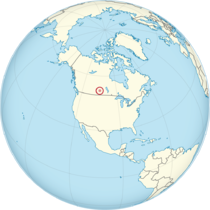 Location of Suverska | |||||||||
| Status | Former unrecognized state | ||||||||
| Capital and largest city | Paskrai | ||||||||
| Official languages | English | ||||||||
| Recognised national languages | Ukrainian | ||||||||
| Ethnic groups (2020)[1] | 87.5% European 12.5% Visible Minority | ||||||||
| Religion (2020)[1] |
| ||||||||
| Demonym(s) | Suversian (or Suverskan) | ||||||||
| Government | Federal parliamentary republic (2014–2019) Unitary semi-direct democracy (2021–2022) | ||||||||
• Holova | Atyko Robijovych (2018-2022) | ||||||||
• Head of Government | National Council (2021-2022) | ||||||||
| Legislature | National Assembly | ||||||||
| Independence from Canada | |||||||||
| 27 October 2013 | |||||||||
| 27 March 2014 | |||||||||
| 3 May 2021 | |||||||||
| 24 February 2022 | |||||||||
| Area | |||||||||
• Total | 4.20 km2 (1.62 sq mi) (193rd) | ||||||||
• Water (%) | 0.32 | ||||||||
| Population | |||||||||
• 2021 estimate | 59 (196th) | ||||||||
• Density | 14.05/km2 (36.4/sq mi) (223rd) | ||||||||
| Currency | |||||||||
• Name | Suverian let (SVL) | ||||||||
• Type | Commodity currency | ||||||||
| Time zone | UTC-6 (CST) | ||||||||
| Date format | yyyy-mm-dd (CE) | ||||||||
| Driving side | right | ||||||||
| Calling code | +1 | ||||||||
| |||||||||
Suverska (/suːvɛərskə/; lit. northern sovereign land), officially the Republic of Suverska and formerly the Republic of Suwerenny,[a] was an unrecognised state and one of the longest active micronations in Western Canada.[b] With a population of 59 and an area of 4.20 km², Suverska consisted of two regions, Agionoros and Meteora, which were made up of enclaves and exclaves located within the Canadian province of Saskatchewan.[2]
The land that is now Suverska was inhabited by various groups of indigenous peoples for thousands of years prior to European colonisation. European settlement in the area can be traced back to the 1840s, and the region was incorporated into Canada in 1870.[3] Throughout the 20th century, the ancestors of today's Suverians immigrated to the area, mostly from Eastern Europe following both world wars. Most Suverians were of Eastern European origin; the 2020 Census of Suverska found that over three in four Suverians have Slavic ancestry.[2]
In October 2013, the nation was formed under the name the Republic of Suwerenny, and in March 2014, it declared independence from Canada as a federal parliamentary republic. Its original constitution, which was written in March 2014, remained in effect until a series of referendums in May 2019 dissolved the previous system of government and began a two-year transition which ended in May 2021 with the implementation of the 2021 Constitution of Suverska and a unitary, semi-direct democratic system of government.[2]
The older region, Agionoros, consists of the historical regions of Flosia, Veskrai, and the nation's capital Paskrai, while the newer region, Meteora, joined Suverska in 2018 and had devolved powers.[2] Both regions of Suverska were located within the Canadian prairies, specifically the province of Saskatchewan. Externally, the country was a member of the Western Canada sector.
The government of Suverska resigned on 24 February 2022, on the occurrence of the Russian invasion of Ukraine in “an act of solidarity with Ukrainians worldwide.”[2] Suverska rescinded its claims to sovereignty, and as a result, claim and control of its possessions returned to Canada.
Etymology
The name Suverska is a blend of various words from the Slavic languages that altogether roughly translates as "northern sovereign land". Firstly, the name originates from words meaning 'sovereign', such as the Polish suwerenny or the Ukrainian "суверенний", which was chosen to represent the claim to sovereignty that the nation makes. Secondly, the name takes influence from the Slavic words meaning 'northern' or 'cold', such as the Ukrainian "сі́вер" or Serbo-Croatian sjȅvēr (a word which may have also influenced the name of the Severians). Finally, the nation's name ends with the prefix of -ska, which is especially common in Polish place names.[2] From 2013 to 2019, the country's name took origin only from one of the words and was called the Republic of Suwerenny (as it was written in documents such as the Declaration of Independence and the 2014 Constitution of Suwerenny).[4] During the 2019 Referendums, voters chose to rename the country from Suwerenny to Suverska, an altered version of the original name that had found its way into common use.[2] Since then, the name Suverska has become the regular name of the country, with it becoming official in the 2021 Constitution of Suverska.[5]
History
Pre-Suverian history
The land that is now Suverska was inhabited by various indigenous peoples for thousands of years prior to European colonisation. At the time of European arrival, this was the land of people including the Assiniboine, Cree, and Sioux, with the Iron Confederacy a dominant political force.[3][6] The region was initially explored by the British and French in the 18th Century, with the British Hudson's Bay Company having claimed it as part of Rupert's Land in 1670.[7] Following European arrival, the area also became home to the Saulteaux and the homeland of the Métis.[3]
Permanent European settlement in the area can be traced back to the 1840s as part of the westward expansion of British North America.[7] In 1872, the Dominion Lands Act encouraged British, French, and German settlers to homestead in the area on 160 acres (0.65 km2) of land for $10.[8] The region was incorporated into Canada in 1870 as a part of the Northwest Territories.[7] From 1871 to 1877, Numbered Treaties 2 and 4 were signed between Queen Victoria and various First Nation band governments, with their coverage spanning present-day Agionoros and Meteora.[3]
By the 1880s, the Canadian Pacific Railway had made its way through the then District of Assiniboia, and the region entered Canadian Confederation as a part of Saskatchewan in 1905.[7] The ancestors of today's Suverians immigrated to the area, mostly from Eastern Europe, throughout the 20th Century.[9]
Formation and early history


The direct predecessor to modern Suverska, originally called the Republic of East Butte, was founded on 27 October 2013 in modern-day Flosia. With a population of seven, it declared itself autonomous from the rest of Canada and established a provisional government.[9]
On 27 March 2014, the Republic of East Butte declared independence from Canada as the Republic of Suwerenny. Four days later, the nation's citizens voted unanimously to enact the 2014 Constitution of Suwerenny and to elect John of Flosia to a two-year term as the first president of the republic.[2] Over the next two months, additional regions would join the country, bringing the total population up to sixteen in time for the first national census on 19 May 2014. On the same day, the nation's first parliamentary elections were held, with four of the National Assembly's five seats being awarded to the Suwerenny Party (the other one were independent candidates).[2] In May 2014, Suverska entered the wider micronational community when it began foreign relations with other countries and organisations. Suverska began informal communications with other nations, including the Republic of Molossia, the People's Republic of Hashima, and the Great Empire of Dikameppra.[9]
Between 2014 and 2016, Suverska's population grew by fifty percent from 16 to 24. During this time, the Canada Party split off from the Suwerenny Party while what remained of the party was renamed to the Liberal-Socialists Party. In the 2016 elections, John of Flosia was re-elected president and the Liberal-Socialists won four seats, the Canada Party two, and and an independent candidate one).[2] Referendums in May 2017 scheduled the movement of the national capital from East Butte to Paskrai and the eventual integration of Meteora into the nation (which was to happen within a year). In June 2017, the capital moved to Paskrai, and in January 2018, the regions of Meteora joined the country. For the census in May 2018, the national population was now 39.[9] In this month's elections, John of Flosia was re-elected as president once again, and the Liberal-Socialists only formed a minority government (4 Liberal-Socialists, 3 Prairie, 2 Canada). In October 2018, Atyko Robijovych was elected president.[9]
Transitional period and late history
- Categoric-Gradial SC: high (3.80)
- Corruption perceptions: very low
- Democracy Index: full democracy
- Global Peace Index: very high (1.143)
- Government transparency: very high
- Hamilton's (seriousness): very high (4.20)
- Human development: very high
- Press freedom: satisfactory
The increasing popularity of the Canada and Prairie parties challenged the incumbent Liberal-Socialists minority government. In 2019's national referendums, the nation voted in favour of various proposals, including for various government reforms, for increased autonomy in Meteora, and for the country to be renamed to Suverska. Within the next few weeks, further referendums approved the Transitional Constitution of Suverska and the creation of the Transitional Council, a five-member, nonpartisan council which was to temporarily lead the country through a two-year transition period and draft a new constitution. At this time, the parliament was dissolved in favour of this temporary council.[9]
Following the two-year transitional period of Suverska's history, the 2021 Constitution of Suverska went into effect on 3 May 2021, and the first elections to the National Council took place on 25 June 2021.[2]
COVID-19 pandemic
Amidst the Suverian transitional period, COVID-19 began to spread worldwide. By March 2020, it was declared a pandemic by the World Health Organisation and had begun to significantly impact Canada, Suverska's neighbouring nation. That month, both governments declared a state of emergency, with Suverska implementing a two-week national lockdown. Suverians were urged to stay home unless essential, and Suverian school children transitioned to learning at home as their Canadian schools were closed due to the pandemic.[9]
Most Suverian workers returned to their places of employment in Canada in June, while students returned to school in September. Second and third waves of cases swept through Canada in the final months of 2020 and in Spring 2021, respectively, with the third wave consisting of the Delta variant. On both of these occasions, the government reaffirmed its state of emergency and discouraged any indoor gatherings. On 14 November 2020, Suverska reported its first and only case of COVID-19 to date in Agionoros. In March 2021, Suverska implemented a national partial lockdown which lasted for approximately one month.[9]
By May 2021, a majority of Suverians had received their first dose of a vaccine, and two months later, many were fully vaccinated. The nation eased its public health measures the most it has so far in July 2021. In August 2021, Suverska reimplemented past precautions amidst a fourth wave of new cases in Canada, furthering these restrictions at the beginning of December 2021 with the spread of the Omicron variant. Four cases were reported in December 2021, and two cases were reported in January 2022.[9]
During the pandemic, Suverska did not implement any vaccine mandate or vaccine passport policies, though it did enact mask mandates, health recommendations, and national and regional lockdowns.[2]
Dissolution and aftermath
The government of Suverska resigned on 24 February 2022, on the occurrence of the Russian invasion of Ukraine in “an act of solidarity with Ukrainians worldwide.” Suverska rescinded its claims to sovereignty, and, as a result, claim and control of its possessions returned to Canada.[2]
Geography and climate
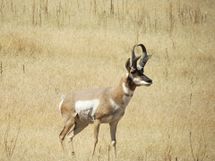
Despite its small size, Suverska had a diverse geography which consists of prairie, aspen parkland, valleys, and lakes. The urban areas where most of the population lives are located on a flat, treeless plain. The biodiversity of the nations is typical of the Great Plains, as common wildlife of Suverska include the coyote, red and swift fox, bobcat, lynx, white-tailed deer, and the pronghorn. The diversity of Suverska's plants and animals is represented in the nation's symbols, which include the pronghorn, and chokecherry.[7] Land use in Suverska was divided between residential, agricultural, and environmental reserves.[9]
Most of the nation experienced a humid continental climate (Köppen climate classification Dfb), while some regions experienced a subarctic climate (Köppen climate classification Dfc). All regions had warm summers and cold winters where precipitation is heaviest in late spring and early summer as rain, while snow is common in the winter months. July and August are the warmest months, with temperatures going as high as above 40 °C (104 °F) a few times a year, although the nights are still cold in the summer. In the winter, temperatures regularly drop below -40 °C (-40 °F) with wind chill.[10]
| Climate data for Veskrai, 1981–2010 | |||||||||||||
|---|---|---|---|---|---|---|---|---|---|---|---|---|---|
| Month | Jan | Feb | Mar | Apr | May | Jun | Jul | Aug | Sep | Oct | Nov | Dec | Year |
| Average high °C (°F) | -10 (14) |
-6 (21) |
0 (32) |
11 (52) |
18 (64) |
23 (73) |
26 (79) |
26 (79) |
19 (66) |
11 (52) |
0 (32) |
-7 (19) |
9 (48) |
| Daily mean °C (°F) | -15 (5) |
-12 (10) |
-5 (23) |
5 (41) |
11 (52) |
16 (61) |
19 (66) |
18 (64) |
12 (54) |
4 (39) |
-5 (23) |
-12 (10) |
3 (37) |
| Average low °C (°F) | -20 (-4) |
-17 (1) |
-10 (14) |
-2 (28) |
4 (39) |
9 (48) |
12 (54) |
10 (50) |
5 (41) |
-3 (27) |
-11 (12) |
-18 (-0) |
−3 (27) |
| Average Rainfall cm (inches) | 0 (0) |
0 (0) |
1 (0.4) |
2 (0.8) |
5 (2) |
7 (2.8) |
7 (2.8) |
5 (2) |
3 (1.2) |
2 (0.8) |
0 (0) |
0 (0) |
31 (12.2) |
| Average Snowfall cm (inches) | 19 (7.5) |
11 (4.3) |
19 (7.5) |
7 (2.8) |
4 (1.6) |
0 (0) |
0 (0) |
0 (0) |
1 (0.4) |
7 (2.8) |
13 (5.1) |
20 (7.9) |
100 (39.4) |
| Source: Environment Canada[11] | |||||||||||||
Government and politics
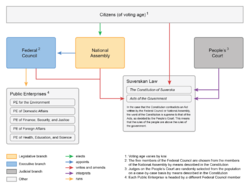
- Federal parliamentary republic (2014–2019)
- Unitary semi-direct democracy (2021–present)
* † In addition to provisional governments
from 2013–2014 and from 2019–2021
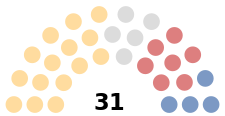
Since the enactment of the 2021 Constitution of Suverska, the nation had been a unitary semi-direct democracy in which all citizens of voting age are a part of the nonpartisan legislature and five elected citizens make up the executive National Council. Prior to 2019, the nation was a federal parliamentary republic with an executive cabinet and a president elected by popular vote. During this time, Suverska's political scene was dominated by the Liberal-Socialists Party (initially called the Suwerenny Party and in its final years, Libsoš), who formed majority governments in 2014 and 2016 followed by a minority government in 2018. Opposition to the Liberal-Socialists included the Canada Party, Prairie Party, and numerous independent politicians.[9]
The Suverian government is made up of executive, legislative, and judicial branches. The National Council is the executive branch and the head of government (similar to the Swiss Bundesrat); it governs as a nonpartisan consensus government, and each of its five members directs one of the government's five ministries. Elections to the National Council take place every January, in which members are elected by the National Assembly using ranked voting, and individual members may be removed from the council at any time if a majority of the National Assembly votes for their removal. The National Assembly, which is the legislative branch of government, is a nonpartisan collective of all voting-age citizens of Suverska. As opposed to the National Council which meets regularly, the National Assembly meets irregularly and votes on laws in a liquid democratic fashion. The People's Court, as described in the "Law" section, is the judicial branch of government.[9]
The government of Suverska is structured to encourage direct, individual participation and nonpartisan, consensus governance. Implementations that promote direct democracy in the Suverian government include universal suffrage, an elected executive council with recall legislation, and a legislative assembly comprising of all adult citizens which functions via liquid democratic means.[9]
Constitution and human rights
On 31 March 2014, days after the nation's declaration of independence, the populace voted unanimously to enact the 2014 Constitution of Suwerenny. A series of referendums in 2019 approved a new Transitional Constitution of Suverska and called for the creation of the nonpartisan Transitional Council, which was to temporarily lead the country through a two-year transition period and draft a new constitution. Following this transitional period, the 2021 Constitution of Suverska went into effect on 3 May 2021.[9]
The current constitution, structurally based on the Constitution of Iceland, consisted of eight sections: Introduction; National Council; National Assembly; People's Court; Devolution of powers to Meteora; Citizens, residents, and visitors; Emergency powers of government; and Amendments to this Constitution. Section I opens the document while Sections II to V outline the nation's government structure, with section V in particular outlining Meteoran devolution. Section VI outlines the three classifications of persons in Suverska and the rights and responsibilities of each grouping (as well as the means of becoming a citizen or resident). Lastly, Section VII outlines the temporary powers that the government can exercise in times of emergency if granted to do so, and Section VII sets forth the process of amending the constitution.[9]
Human rights in Suverska were outlined in Section VI of the constitution, titled Citizens, residents, and visitors. Articles in this section ensure for all persons in Suverska legal egalitarianism; freedom of association; freedom from enslavement, forced labour, and torture; presumption of innocence; mobility rights; and the freedom to manage personal property and to participate in democracy; among other things.[5] In terms of LGBT+ rights, the constitutional guarantee of legal egalitarianism extends to all individuals regardless of sex and gender, as well as their “their true or perceived identity and characteristics,” which may allude to sexual orientation and identity (although this is unclear). In addition, marriages, civil unions, and gender are not legal matters in Suverska, essentially making queer relationships and gender identities equal under the law.[9]
Foreign relations

Suverska created and maintained foreign relationships with other nations and organisations through its Ministry of Foreign Affairs. The country sought relationships with nations of similar ideology and ones that promote intermicronational peacekeeping and security. Suverska began its foreign presence in 2014 when it declared independence from and attempted to open communications with Canada.[9]
The 2021 Constitution of Suverska required that all visitors to the country follow the Ministry of Democracy's most recent visa policy.[12] As of November 2021, this meant that non-Suverians wishing to enter the country must present upon entry to Suverska a valid travel visa or a visa-exempt passport (those of Canada, Cuba, the Haudenosaunee, New Zealand, Rojava, Ukraine, any EFTA member state, and any EU member state).
Law and courts
The 2021 Constitution of Suverska was the supreme law of the country. The constitution is a short, dynamic document that is regularly changed by the populace by mandatory annual referendums. The laws that govern the country consist entirely of the 2021 Constitution of Suverska and the Acts of the Government (law-related acts made by the executive and legislative branches of the government). Laws are consistent and uniform across the nation, and the laws of Canada and Saskatchewan still apply in the country.[9]
Civil law prevailed in Suverska, and the nation's laws are interpreted by the People's Court, which, in each case, consists of a random selection of two National Council members plus three other citizens, in which the highest-ranking National Council member directs the session. Cases settled by the People's Court are non-binding outside of that specific case, meaning that they only apply on a case-by-case basis unless the decision is later adapted into an act or amended into the Constitution. As of May 2021, no court sessions have taken place since the writing of the 2021 Constitution.[9]
In the case that the Constitution conflicts with an act made by the National Council or National Assembly, the words of the Constitution (which are written by the people, therefore giving the people the ultimate power) are supreme, which is decided at the discretion of the People's Court. In order for a constitutional amendment to be voted on by the people in a referendum, the idea must either collect at least 10 signatures in an official petition or be organised by the National Council or National Assembly in their regular meetings. Referendums also take place when the National Assembly deems an issue of ultimate concern to the populace.[9]
Regions and devolution
Suverska was a unitary state that was divided into two regions—Meteora and Agionoros. Agionoros consists of enclaves and exclaves landlocked entirely within the Canadian province of Saskatchewan. Likewise, Meteora consists of enclaves and exclaves in Saskatchewan. The older region, Agionoros, consisted of the historical regions of Flosia, Veskrai, and the nation's capital Paskrai, while the newer region, Meteora, was integrated into Suverska in 2018 and had devolved powers.[9]
| Flag | Name | Code | Capital | Founded | Pop. | Area | Executive |
|---|---|---|---|---|---|---|---|
| None | Agionóros Агіуо́рус |
AGI | Paskrai | 2013 | 38[c] | 1.1 km² | None |
| Metéora[d] Мете́ора |
MTO | Oskana | 2018 | 21 | 3.1 km² | Meteora Council |
Economy
| Economy of Suverska | |
| Currency | Suverian let (SVL) (internal) Canadian dollar (CAD) (external) |
| Unempl. | 11.8% internal; 3.9% external |
| Imports | Food and perishable goods, electricity, gasoline, plastic products |
| Exports | Cereals, meat and meat products, horticulture, waste |
| Partners | |
| Currency: Suverian Let (SVL) | |
| Exchange rate (Nov. 2021): unknown | |
| Stock | TBD |
| Supply | TBD |
| Banknotes | 1, 3, 10, 30, 100, 300 Ⰾ |
| Bank | Bank of Suverska |
| Issuer | Ministry of Finance |
| Energy consumption | ||
| Source | % | |
| Natural gas | SP | 45.6 |
| Coal and coke | SP | 42.2 |
| Hyrdo power | BCH | 12.2 |
Suverska's economy was two-sided—one side consists of an internal, informal economy running on the local Suverian let (SVL), while the formal economy and external imports and exports run primarily on the Canadian Dollar (CAD). While the let is the only official currency, the Canadian dollar thus acts as a de facto official currency in addition to the let. All organisations are owned and ran by the government or by co-operatives of citizens and may not be run for profit.[2]
Suverska's external economy (Suverian involvement in the formal Canadian economy) was advanced. With an unemployment rate of 3.9%, employment in the external economy is greatly concentrated in the tertiary (43%) and quaternary (33%) sectors over the primary (8%) and secondary (16%) equivalents. The internal economy of Suverska is less developed and experiences a higher unemployment rate of 11.8% (9.5% in Agionoros; 15.4% in Meteora). The primary (26% Agionoran; 37% Meteoran), secondary (32% Agionoran; 36% Meteoran), and tertiary (26% Agionoran; 27% Meteoran) sectors dominate the employment in the internal economy, consisting of 30%, 33%, and 27% of the total employment respectively.[9]
Almost all of Suverska's trading was done with Canada, and most Suverians are employed in Canada and import goods back into Suverska, causing the country to import more goods than it exports. Common imports into Suverska include food and perishable goods, electricity, gasoline, and plastic products, while common exports include cereals, meat and meat products, horticulture, and waste. Suverska's main industries include tourism, agriculture and horticulture, and the media industry.[9]
As an informal economy, Suverska lacked personal income taxation or sales taxation.[2]
Currency
The most recently used currency of Suverska was the Suverian let (plural: let or lety; sign: Ⰾ; code: SVL). Previous to the government reforms of 2021, Suverska's informal economies has used various local fiat currencies, including the nation-wide Pušč (2013–2015) and the Pasqua Dollar (2015–2021) local currency (in Paskrai), but operated mostly on the Canadian dollar. During the transitional period, the Transitional Council proposed the creation of a new commodity or commodity-backed currency in order to promote the independence of Suverska's economy. The proposal received greatly positive support from the populace, as seen in its referendum support, so the currency was developed. While originally scheduled to be introduced at the same time as the 2021 Constitution, the printing the let was postponed by six months until November 2021.[2]
The let was issued by the Ministry of Finance, with its Bank of Suverska acting as the central bank for the currency. The first banknotes set to be issued were in the denominations of 1, 3, 10, 30, 100, and 300 lety.[2]
Organisations
- Co-operative companies
- Cabin Conservation Council – 2016-2022
- Credit Union of Suverska – financial co-operative offering accounts, credit, exchange, and other services in Suverian let and Canadian dollars; 2022-2022
- Lakeside Pine House – retail and accommodations co-operative serving Paskrai with a general store and bed and breakfast; 2017-2020
- The Suverian – publishing co-operative covering current affairs, citizen journalism, art, and other formats; 2021-2022
- State-owned companies
- Bank of Suverska – central bank of Suverska and issuer of the Suverian let; managed by Ministry of Finance; 2015-2022
- Tourism Suverska – tourism agency to promote travel to and within Suverska; managed by Ministry of Domestic Affairs; 2017-2022
- State-ran departments
- Ministry of Democracy – national department responsible for the functioning of democracy; 2014-2022
- Ministry of Domestic Affairs – national department responsible for the government's internal relations and livelihood of its citizens; 2021-2022
- Ministry of Energy and the Environment – national department responsible for the environment and natural resources; 2021-2022
- Ministry of Foreign Affairs – national department responsible for the government's foreign relations; 2014-2022
- Ministry of Finance – national department responsible for the national local economy; 2014-2022
- Meteora Ministry of Agriculture – Meteoran department responsible for agricultural production; 2021-2022
- Meteora Ministry of Finance – Meteoran department responsible for Meteoran local economy; 2021-2022
- Meteora Ministry of Infrastructure – Meteoran department responsible for infrastructure and land use; 2021-2022
Demographics
| Historical population | ||
|---|---|---|
| Year | Pop. | ±% |
| 2014 | 16 | — |
| 2016 | 24 | +50.0% |
| 2018 | 39 | +62.5% |
| 2020 | 44 | +12.8% |
| 2022 | 59 | +34.1% |
The 2020 Suverian census, which was taken on May 18, counted the nation's total population as 44, an increase of 12.8 percent from the result of the 2018 Census. Since its founding in 2013, the nation has grown greatly from its original seven residents mostly because as a result of the expansion of the country's borders. Suverska's population density of 11 people per square kilometre is considered very low by international standards, with the statistic being comparable to that of Kazakhstan and the Central African Republic. Despite this, the country is extremely urbanised, with 85.0 percent of the population living in cities or towns.[1]
Suverska has a young population. In 2019, it was estimated that 40.5% of the population was below the age of 18, and that the median population was 30.1 years, with that statistic being slightly higher for women (30.3 years) than men (29.9 years). The two most prominent age groups in the nation are youth and working-age citizens, and as of the 2020 Census, the male and female population of Suverska was equal (both 50.0 percent). The nation's life expectancy at birth is currently estimated to be 83 years. Also as of 2020, the large majority of Suverians (92.5 percent) live in family households, while 7.5 percent of Suverians live alone. The average size of a household is 3.08 people, with house sizes ranging from one person to six people.[1]
Language and ethnicity

The 2020 Census of Suverska found that the nation is mostly home to white Canadians of European descent, as well as some Canadians of Chinese descent and people of two or more races (10.0 percent). The Census results found that 97.5 percent of Suverians have some European ancestry, which includes Polish (75.0 percent), Ukrainian (62.5 percent), and Hungarian (7.5 percent) ancestry, while 12.5 percent of the nation's residents have some Chinese ancestry. 12.5 percent of Suverians are visible minorities.[1]
According to the 2020 Census, 92.5 percent of Suverksans were born in Canada and 2.5 percent in Poland, while only 5.0 percent of residents were born in Suverska itself. In a similar statistic, 82.5 percent of Suverians reported in the 2020 Census that both of their parents were born in Canada, while 10.0 percent said one parent and 7.5 percent neither.[1]
English is the official language and lingua franca of communication within the nation's government and between citizens. The 2020 Census of Suverska found that 90.0 percent of Suverians speak English as their mother tongue, while other common mother tongues included Cantonese, Polish, and Ukrainian. As well, every adult Suverian is able to read, write, and speak in English, while some people can carry a conversation in Cantonese, French, and various Slavic languages.[1]
Religion
No official statistic of religion in Suverska had ever been recorded, but the nation is estimated to be a fairly religious nation by church membership. However, most of the nation's residents are relaxed adherents to their faiths, as the average weekly church attendance among Suverians is estimated to be very low. Despite low attendance numbers, most Suverians are members of the Ukrainian Orthodox Church of Canada or the Roman Catholic Church. A 2020 study by the Ministry of Domestic Affairs estimated that Christians make up approximately three-quarters of the national population by membership, including at 38 percent Eastern Orthodox, 24 percent Roman Catholic, and 12 percent Lutheran, while the remaining citizens are members of other religions, non-religious, or did not specify their answer.[13]
Culture
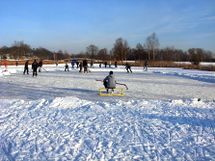
Suverian culture resembled the culture of the neighbouring country of Canada and is also greatly influenced by Eastern European culture and Christian traditions. Like Canada, Suverska's people and its government place emphasis on multiculturalism and equality. Suverians value their nation's peaceful foreign policy, emphasis on the rights and freedoms of all, and its national park system. Historically, Suverska and its citizens have been influenced by Ukrainian and Polish culture, which are the nations where most of its citizens' ancestors immigrated from. Because of this, many Suverians practice and continue to value traditions from these cultures, such as egg decorating and other Christian traditions.[2]
Popular sports in Suverska included ice hockey, baseball, and Canadian football. Many Suverians are fans of the Canadian Football League's Saskatchewan Roughriders. The national sport of Suverska was often said to have been ice hockey, and the country was a member of the Union Cycliste Intermicronationale.[2]
Holidays
There were seven mandated non-working days in Suverska: January 1 (New Year's Day), January 7 (Julian Christmas Day), a variable day in March, May 1 (May Day), a variable day in August, a variable day in October (Family Day), and December 25 (Gregorian Christmas Day). Because of their Christian backgrounds (specifically Eastern Orthodox and Roman Catholic), many Suverians observe traditional Christian holidays such as Christmas and Easter Sunday.[9]
National symbols
Various symbols were used to represent Suverska and its people, such as the national flag and coat of arms. Along with these formal symbols, the government has also declared that the national animal is the Pronghorn (Antilocapra americana), the national fruit is the chokecherry (Prunus virginiana), the national flower is the marigold (Calendula officinalis), and the national tree is the Paper birch (Betula papyrifera). The national colours of Suverska are black, gold (#FFCA60), and white.[9]

|
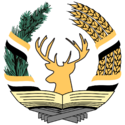
|

|

|

|

| |
| National flag | National arms | Animal: Pronghorn | Flower: Marigold | Fruit: Chokecherry | Tree: Paper birch | |
See also
Notes
- ↑ Cyrillic: Суве́рьща (Респу́бліка Суве́рьща, formerly Респу́бліка Суве́ренна).
- ↑ Suverska is also the third oldest continuously active micronation in all of Canada (on this website), after the Aerican Empire and Slabovia. (See the list of micronations in Canada).
- ↑ Includes 10 Suverians living abroad in Canada.
- ↑ Officially the Republic of Meteora (Республіка Метеора).
References
- ↑ 1.0 1.1 1.2 1.3 1.4 1.5 1.6 2020 Census of Suverska.
- ↑ 2.00 2.01 2.02 2.03 2.04 2.05 2.06 2.07 2.08 2.09 2.10 2.11 2.12 2.13 2.14 2.15 2.16 2.17 2.18 Robijovych, Atyko (27 March 2022). "On the history of the Republic of Suverska". The Suverian.
- ↑ 3.0 3.1 3.2 3.3 "First Nations Communities and Treaty Boundaries in Saskatchewan". Indian and Northern Affairs Canada. 30 March 2009. Archived from the original on 2 December 2009.
- ↑ 2014 Constitution of Suwerenny.
- ↑ 5.0 5.1 2021 Constitution of Suverska.
- ↑ "Welcome". Native-Land.ca. Retrieved 2021-11-24.
- ↑ 7.0 7.1 7.2 7.3 7.4 "Hudson's Bay Company". Encyclopedia Britannica. Retrieved 2022-08-12.
- ↑ "Dominion Lands Act | The Canadian Encyclopedia". www.thecanadianencyclopedia.ca. Retrieved 2021-05-12.
- ↑ 9.00 9.01 9.02 9.03 9.04 9.05 9.06 9.07 9.08 9.09 9.10 9.11 9.12 9.13 9.14 9.15 9.16 9.17 9.18 9.19 9.20 9.21 9.22 9.23 9.24 "Republic of Suverska". sites.google.com. Retrieved 2021-05-15.
- ↑ "National Climate Data". climate.weather.gc. Environment Canada. Archived from the original on January 19, 2012. Retrieved July 17, 2011.
- ↑ https://climate.weather.gc.ca/climate_normals/index_e.html
- ↑ "2021 Constitution of Suverska", Republic of Suverska, Retrieved 17 September 2021
- ↑ Estimations on the religiosity of Suverians (2020).
